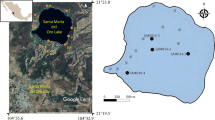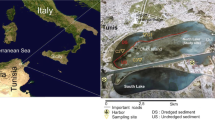Abstract
Metal deposition patterns have been examined in sediment cores from three lakes in the Adirondack region of New York (USA). Sequential chemical extraction of Al, Fe, Mn, Pb, and Zn has yielded information on their chemical nature and potential mechanisms involved in their deposition. Results indicate historical changes in watershed chemistry may have influenced metal chemistry in these lakes. Detailed descriptions of the chemical forms of metals in sediments is not possible due to the fact that extraction methods are only operational. However, in two systems known to have been acidified in recent time by acidic deposition (Big Moose L. & Deep L.), concentrations of labile Al (in C1−C4 fraction) increase after 1940–1950, corresponding with lake acidification as inferred from diatom assemblages. Temporal trends in the inputs of Pb in the C1−C4 fraction are also consistent with known historical changes in atmospheric Pb inputs to the region. Chemical stratigraphies of Fe and Mn are most likely dominated by internal biogeochemical cycling within sediments.
Similar content being viewed by others
References
AndersonR. F. & S. L.Schiff, 1987. Alkalinity generation and the fate of sulfur in lake sediments. Can. J. Fish. Aquat. Sci. 44 (Suppl. 1): 188–193.
BalzerW., 1982. On the distribution of iron and manganese at the sediment/water interface: thermodynamic versus kinetic control. Geochim. Cosmochim. Acta 46: 1153–1161.
BenoitG. & H. F.Hemond, 1987. A biogeochemical mass balance of 210Po and 210Pb in oligotrophic lake with seasonally anoxic hypolimnion. Geochim. Cosmochim. Acta 51: 1445–1456.
Berner, R. A., 1980. Early Diagenesis: A Theoretical Approach. Princeton, 241 p.
Campbell, P. G. C. & A. Tessier, 1984. Paleolimnological approaches to the study of acidic deposition: metal partitioning in lacustrine sediments. pp. 234–274. in Proceedings of a Workshop on Paleolimnological Studies of the History and Effects of Acidic Precipitation, USEPA ÇR-811631-01-0.
CarignanR. & A.Tessier, 1988. The co-diagenesis of sulfur and iron in acid lake sediments of southwestern Quebec. Geochim. Cosmochim. Acta 52: 1179–1188.
CarignanR. & A.Tessier, 1985. Zinc deposition in acidic lakes: the role of diffusion. Science 228: 1524–1526.
CarignanR. & J. O.Nriagu, 1985. Trace metal deposition and mobility in the sediments of two lakes near Sudbury, Ontario. Geochim. Cosmochim. Acta 49: 1753–1764.
CharlesD. F. & D. R.Whitehead, 1986. Paleoecological Reconstruction of Recent Lake Acidification (PIRLA): Methods and project description. Electric Power Research Institute, Palo Alto, CA.
CornwellJ. C., 1986. Diagenetic trace-metal profiles in arctic lake sediments. Envir. Sci. Technol. 3: 299–302.
DavisJ. A. & R.Gloor, 1981. Adsorption of dissolved organics in lake water by aluminum oxide. Effects of molecular weight. Envir. Sci. Technol. 15: 1223–1229.
DicksonW., 1978. Some effects of acidification of Swedish lakes. Verh. int. Ver. Limnol. 20: 851–856.
DriscollC. T. & G. C.Schafran, 1984. Characterization of short-term changes in the base neutralization capacity of an acidic Adirondack, NY lake. Nature 310: 308–310.
DriscollC. T. & R. M.Newton, 1985. Chemical characteristies of Adirondack lakes. Envir. Sci. Technol. 19: 1018–1024.
Gubala, C. P., 1988. The cycling of iron and trace metals in the sediments of acidie lakes. Ph.D. Thesis, School of Public Environmental Affairs, Indiana University, 176 pp.
Husar, R., 1986. Manmade SOx and NOx emissions and trends for castern North America in Monitoring and Assessment of Trends in Acid Deposition. U.S. National Academy of Sciences. 48.
Jenne, E. A., 1968. Controls on Mn, Fe, Co, Ni, Cu and Zn concentrations in soils and water: the significant role of hydrous Mn and Fe oxides. in: Trace Inorganics in Water, Advances in Chemistry, Series No. 73, ACS, pp. 337–387.
JohnsonN. M., C. T.Driscoll, J. S.Eaton, G. E.Likens & W. H.McDowell, 1981. Acid rain, dissolved aluminum and geochemical weathering at the Hubbard Brook Experimental Forest, New Hampshire. Geochim. Cosmochim. Acta 45: 1421–1437.
JonesJ. G., S.Gardener & B. M.Simon, 1984. Reduction of ferric iron by heterotrophic bacteria in lake sediments. J. gen. Microbiol. 130: 45–51.
LinthurstR. A., D. H.Landers, J. M.Eilers, D. F.Brakke, W. S.Overton, E. P.Meier & R. E.Crowe, 1986. Characteristics of lakes in the eastern United States. Volume I. Population descriptions and physico-chemical relationships. EPA/600/4–86/007a, U.S. Environmental Protection Agency, Washington, D.C. 136 pp.
LionL. W., AtmannR. S. & LeckieJ. O., 1982. Trace metal adsorption characteristics of estuarine particulate matter: evaluation of contributions of Fe/Mn oxide and organic surface coatings. Envir. Sci. Technol. 16: 660–666.
LovelyD. R. & E. J. P.Phillips, 1986a. Organic matter mineralization with reduction of ferric iron in anaerobic sediments. Appl. Envir. Microbiol. 51: 683–689.
LovelyD. R. & E. J. P.Phillips, 1986b. Availability of ferric iron for microbial reduction in bottom sediments of the freshwater tidal Potomac River. Appl. Environ. Microbiol. 52: 751–757.
MillwardG. E. & R. M.Moore, 1982. The adsorption of Cu, Mn, and Zn by iron oxyhydroxide in model estuarine solutions. Wat. Res. 16: 981–985.
SchafranG. C. & C. T.Driscoll, 1987. Spatial and temporal variations in aluminum chemistry of a dilute acidic lake. Biogeochemistry 3: 105–120.
SorensenJ. & B. B.Jorgensen, 1987. Early diagenesis in sediments from Danish coastal waters: microbial activity and Mn-Fe-S geochemistry 51: 1583–1590.
TessierA., P. G. C.Campbell & M.Bisson, 1979. Sequential extraction procedure for the speciation of particulate trace metals. analyt. Chem. 51: 844–851.
White, J. R., 1984. Trace metal cycling in a dilute acidic lake system. Ph.D. Thesis, Department of Civil Engineering, Syracuse University, 261 pp.
WhiteJ. R. & C. T.Driscoll, 1985. Lead cycling in an acidic Adirondack lake. Envir. Sci. Technol. 19: 1182–1187.
WhiteJ. R. & C. T.Driscoll, 1987a. Zinc cycling in an acidic Adirondack lake. Envir. Sci. Technol. 19: 211–216.
WhiteJ. R. & C. T.Driscoll, 1987b. Manganese cycling in an acidic Adirondack lake. Biogeochemistry 3: 87–103.
WhiteJ. R., C. P.Gubala, B.Fry, J.Owen & M. J.Mitchell, 1989. Sediment biogeochemistry of iron and sulfur in an acidic lake. Geochim. Cosmochim. Acta, 53: 2547–2559.
WilsonT. R. S., J.Thompson, D. J.Hydes, S.Colley, F.Culkin & J.Sorensen, 1986. Oxidation fronts in pelagic sediments: diagenetic formation of metal-rich layers. Science 232: 972–975.
Author information
Authors and Affiliations
Additional information
This is the fifth of a series of papers to be published by this journal which is a contribution of the Paleoecological Investigation of Recent Lake Acidification (PIRLA) project. Drs. D.F. Charles and D.R. Whitehead are guest editors for this series.
Rights and permissions
About this article
Cite this article
White, J.R., Gubala, C.P. Sequentially extracted metals in Adirondack lake sediment cores. J Paleolimnol 3, 243–252 (1990). https://doi.org/10.1007/BF00219460
Received:
Accepted:
Issue Date:
DOI: https://doi.org/10.1007/BF00219460




